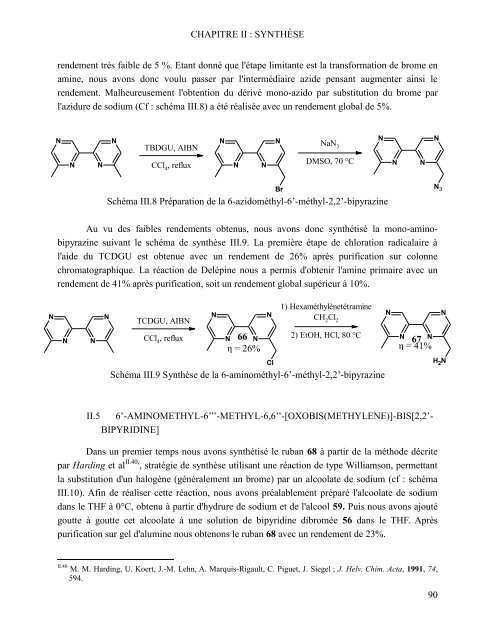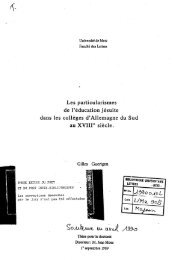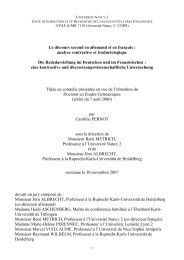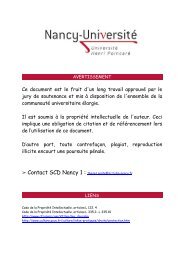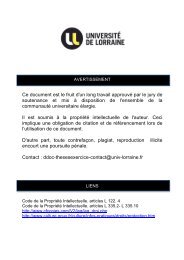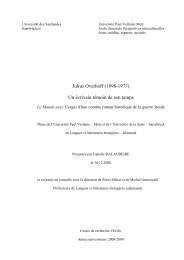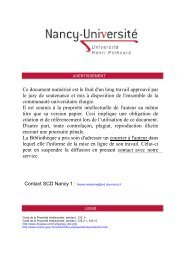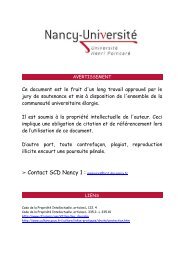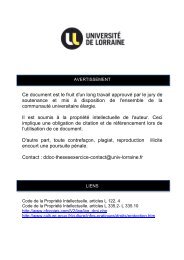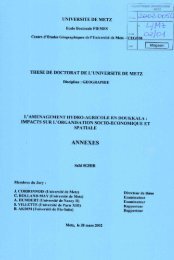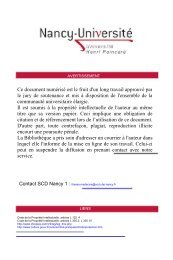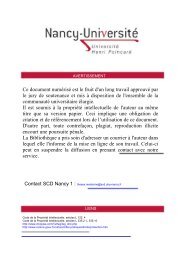Ce document est le fruit d'un long travail approuvé par le jury de ...
Ce document est le fruit d'un long travail approuvé par le jury de ...
Ce document est le fruit d'un long travail approuvé par le jury de ...
You also want an ePaper? Increase the reach of your titles
YUMPU automatically turns print PDFs into web optimized ePapers that Google loves.
N<br />
CHAPITRE II : SYNTHÈSE<br />
ren<strong>de</strong>ment très faib<strong>le</strong> <strong>de</strong> 5 %. Etant donné que l'étape limitante <strong>est</strong> la transformation <strong>de</strong> brome en<br />
amine, nous avons donc voulu passer <strong>par</strong> l'intermédiaire azi<strong>de</strong> pensant augmenter ainsi <strong>le</strong><br />
ren<strong>de</strong>ment. Malheureusement l'obtention du dérivé mono-azido <strong>par</strong> substitution du brome <strong>par</strong><br />
l'azidure <strong>de</strong> sodium (Cf : schéma III.8) a été réalisée avec un ren<strong>de</strong>ment global <strong>de</strong> 5%.<br />
N<br />
N N<br />
Schéma III.8 Pré<strong>par</strong>ation <strong>de</strong> la 6-azidométhyl-6’-méthyl-2,2’-bipyrazine<br />
Au vu <strong>de</strong>s faib<strong>le</strong>s ren<strong>de</strong>ments obtenus, nous avons donc synthétisé la mono-aminobipyrazine<br />
suivant <strong>le</strong> schéma <strong>de</strong> synthèse III.9. La première étape <strong>de</strong> chloration radicalaire à<br />
l'ai<strong>de</strong> du TCDGU <strong>est</strong> obtenue avec un ren<strong>de</strong>ment <strong>de</strong> 26% après purification sur colonne<br />
chromatographique. La réaction <strong>de</strong> Delépine nous a permis d'obtenir l'amine primaire avec un<br />
ren<strong>de</strong>ment <strong>de</strong> 41% après purification, soit un ren<strong>de</strong>ment global supérieur à 10%.<br />
N N<br />
Schéma III.9 Synthèse <strong>de</strong> la 6-aminométhyl-6’-méthyl-2,2’-bipyrazine<br />
II.5 6’-AMINOMETHYL-6’’’-METHYL-6,6’’-[OXOBIS(METHYLENE)]-BIS[2,2’-<br />
BIPYRIDINE]<br />
Dans un premier temps nous avons synthétisé <strong>le</strong> ruban 68 à <strong>par</strong>tir <strong>de</strong> la métho<strong>de</strong> décrite<br />
<strong>par</strong> Harding et al II.40, , stratégie <strong>de</strong> synthèse utilisant une réaction <strong>de</strong> type Williamson, permettant<br />
la substitution <strong>d'un</strong> halogène (généra<strong>le</strong>ment un brome) <strong>par</strong> un alcoolate <strong>de</strong> sodium (cf : schéma<br />
III.10). Afin <strong>de</strong> réaliser cette réaction, nous avons préalab<strong>le</strong>ment pré<strong>par</strong>é l'alcoolate <strong>de</strong> sodium<br />
dans <strong>le</strong> THF à 0°C, obtenu à <strong>par</strong>tir d'hydrure <strong>de</strong> sodium et <strong>de</strong> l'alcool 59. Puis nous avons ajouté<br />
goutte à goutte cet alcoolate à une solution <strong>de</strong> bipyridine dibromée 56 dans <strong>le</strong> THF. Après<br />
purification sur gel d'alumine nous obtenons <strong>le</strong> ruban 68 avec un ren<strong>de</strong>ment <strong>de</strong> 23%.<br />
II.40 M. M. Harding, U. Koert, J.-M. Lehn, A. Marquis-Rigault, C. Piguet, J. Siegel ; J. Helv. Chim. Acta, 1991, 74,<br />
594.<br />
N<br />
N<br />
TBDGU, AIBN<br />
CCl 4 , reflux<br />
TCDGU, AIBN<br />
CCl 4 , reflux<br />
N<br />
N<br />
N N<br />
66<br />
η = 26%<br />
N N<br />
N<br />
Cl<br />
N<br />
Br<br />
NaN 3<br />
DMSO, 70 °C<br />
1) Hexaméthylènetétramine<br />
CH 2 Cl 2<br />
2) EtOH, HCl, 80 °C<br />
N<br />
N<br />
N N<br />
N N<br />
67<br />
η = 41%<br />
N<br />
90<br />
N 3<br />
N<br />
N<br />
H 2


